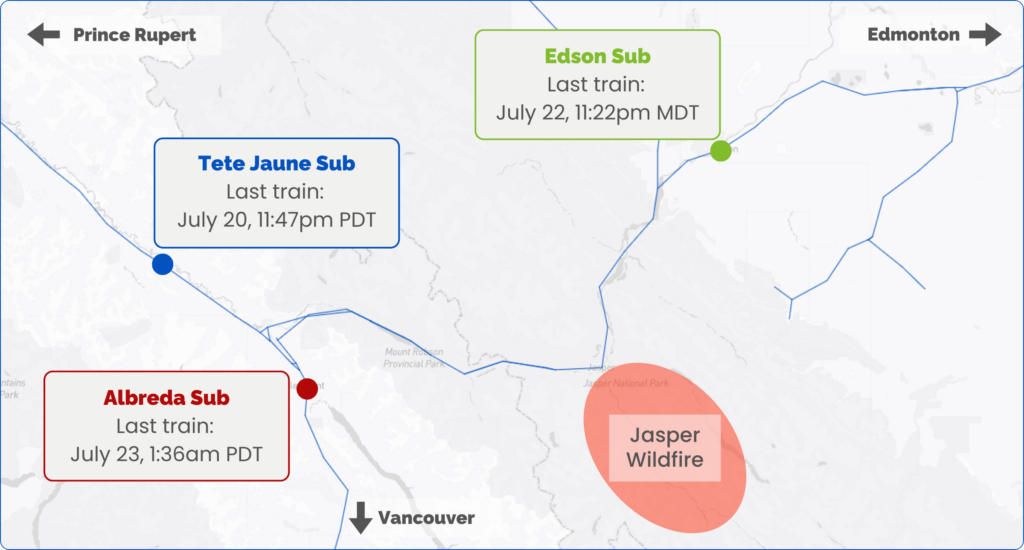Impact of Jasper Wildfire Felt Across CN Network

UPDATE: Limited train movements through the Jasper area have resumed around 12pm MDT. RailState will continue to monitor the situation and provide independent updates on recovery efforts.
(July 24, 2024) – RailState, the rail industry’s only provider of real-time rail network visibility. is monitoring the significant impact of the ongoing Jasper National Park wildfire on Canada’s freight rail network.
The large wildfire, which has led to the evacuation of tens of thousands of people from the area, led Canadian National (CN) to officially shut down service through the region on July 23.
An analysis of RailState’s network rail data shows that train movements through the area effectively shut down days earlier and a significant backlog has been growing over the past 48 hours.
Jasper Area
The Jasper wildfire is located along a vital artery of CN’s network and RailState’s sensors cover all sides of the Jasper area for a comprehensive understanding of train movements through the region.

On the Tete Jaune subdivision, which runs northwest to the Port of Prince Rupert, RailState has a sensor in Dunster, BC. This route saw an average of 13 trains per day in recent weeks. The last train seen by RailState here was a westbound manifest train on July 20 at 11:47pm PDT.
On the Albreda Subdivision, which sees most CN traffic to and from the Port of Vancouver, RailState has a sensor in Valemount, BC. This route recently averaged 18.5 trains per day.
The last train seen by RailState at Valemount was a manifest train on July 23 at 1:36am PDT. Despite moving eastbound at Valemount, this train was not headed further east. Instead, this train went north toward Prince Rupert. The last true east-west trains passed through Valemount on July 20.
To the east of the Jasper fire, on the Edson Subdivision, RailState has a sensor at Hinton, AB. This route’s recent average volume was 44 trains per day. The last train seen by RailState at Hinton was a westbound grain unit train on July 22 at 11:22pm MDT. This train did not continue past the Jasper area, however, and remains held east of the shutdown. Four other trains (2 intermodal, 1 grain unit, 1 manifest) seen at Hinton on July 22 also remain held to the east of Jasper fire.
Extended Impact Throughout Network
Backlogs: With the main line closed, significant backlogs are building up, particularly on westbound movements from Alberta and eastbound movements out of the Port of Vancouver.
RailState has identified at least 5 trains held near Hinton and another 13 held between Stony Plain, AB and Hinton since July 22:
- 6 intermodal trains
- 5 grain unit trains
- 5 manifest trains
- 2 tank car unit trains
Out of the Port of Vancouver, RailState has identified 25 trains in the Kamloops area that would be expected to move further east.
This backlog will continue to grow as the Jasper area remains closed.
Recovery:
When it reopens, shippers can expect significant delays before shipments reach their final destination.
Trains that made it through the Jasper area over the weekend have already arrived at the ports. Trains being held in Alberta can expect at least two days before arriving at a western port.
RailState’s analysis of travel times over the past thirty days between Hinton and the western ports show similar times to each port.
- Hinton to Port of Vancouver: 39 hours
- Hinton to Port of Prince Rupert: 39 hours
Travel times for eastbound movements will vary depending on destination and RailState provides its customers with current data to more accurately predict arrival and take action with critical insights about their supply chain.
“This is a major disruption and comes at a particularly vulnerable time,” John Schmitter, Chief Commercial Officer of RailState, said. “There are other large fires threatening rail lines right now and months remaining on fire season. Added to that is the potential of major labor-related actions as well as coming seasonal increases for grain and LPG. It’s a volatile time and shippers need to deeply understand the actual performance of their supply chain and the risks they face. Having the most current data on network performance gives shippers advance knowledge of disruption impacts and can provide the critical time needed to exercise their options.”
New Fire Suppression Equipment Deployed
In response to the first major wildfire of the year threatening rail lines CN deployed a new fire suppression train, the Trident train, which was first announced in late May.
RailState’s sensor at Wolverine, BC captured an image of the new Trident train on July 22.

Continuous Updates
RailState will provide additional updates on major disruptions as well as reports on commodity and traffic trends.
Subscribe here to receive these free reports as they are released. For shippers, analysts, and others looking for more information on rail network visibility and navigating rail operations during these and other disruptions, please reach out to contact@railstate.com.
